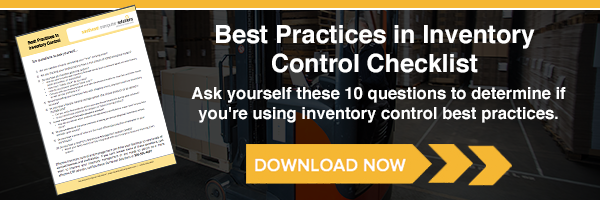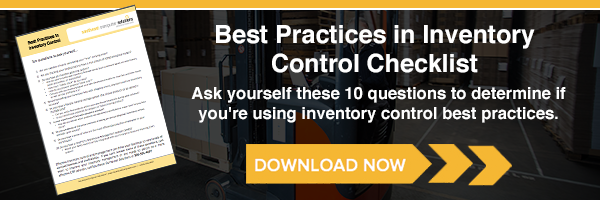 Is it Time to Review Best Practices in Inventory Control?
Is it Time to Review Best Practices in Inventory Control?
If you are like most manufacturing and distribution businesses, you are aware of the struggle to maintain optimum inventory levels in order to increase your profits while maintaining high levels of customer service. A major factor in the ability to grow your business is managing the products you sell and the ability to deliver them on demand and on time. If you experience any of these 3 challenges, we invite you to download our ebook with a checklist to review how to increase profits by following some Best Practices of Inventory Control.
3 Signs Poor Inventory Control is Impacting Your Profits
1. Too Much or Not Enough Inventory: Effective inventory management is a fine balance knowing how much of each item to keep in stock. Product shortages can negatively impact customer experiences so to avoid this, many businesses carry too much inventory. Overstocking to prevent shortages, however, costs money When you incur the carrying costs of keeping extra inventory on the shelf your profits are negatively impacted. Your products are only profitable when it’s moving – that is, when customers are purchasing it. If it’s just sitting in your warehouse, you wasted money purchasing it, and you continue to waste money as long as you’re paying to store it and paying taxes on its value.
Not enough inventory is also bad. If customer orders are coming in and you can’t fill them, you’re going to have unhappy customers – no one wants to wait for a back-ordered item. In addition, having to make rush orders to fulfill customer requests can incur extra expenses, such as expedited shipping fees.
You can prevent this by watching your sales history for trends that help you decide how much to order. You might see that holidays, sales, and new releases cause spikes in demand, meaning that you should order more inventory during those times. Other times of the year might see a drop in demand, indicating that you need to order less inventory. You will also see which products are the most and least popular, telling you to keep more or less stock on hand, respectively.
2. Issues with Your Inventory Tracking System: Even if you watch your sales history and anticipate every need accurately, it won’t help if you don’t have an effective and accurate inventory tracking system. Mistakes aren’t hard to make, and errors like duplicate data entry, loss of inventory due to shrinkage, or incorrectly recorded shipping and receiving data can make your system show incorrect numbers.
It’s also possible that you have a fantastic inventory tracking system – but it’s too complex and your employees don’t know how to use it; incorrect system use could involve placing inventory items in the incorrect location or labeling items incorrectly. (Read our blog article about intuitive inventory systems here.)
You can prevent these issues by, first, making sure you have a good inventory management system. Beyond that, do frequent physical inventory counts to ensure accuracy, keep the software up to date, and offer plenty of training opportunities for your employees.
3. Lack of Prioritization and Compliance: Whether you have hundreds or thousands of items in your inventory, keeping track of every individual item is not only virtually impossible, it’s a waste of time and resources to try. To make it easier, try sorting your inventory into groups based on item popularity. You should group the popular, fast-selling inventory together and give that group the most attention. You would then, of course, give less priority to the least popular, slower moving items.
It's also reccommended that you review and or create operating procedures for shipping, receiving, and storing inventory. Those procedures must be clearly outlined and communicated to your employees because again, even the best inventory tracking system won’t be effective if your employees fail to use it correctly.
All businesses need proper inventory management procedures to be successful. Too much inventory results in products with depreciated value that must be sold at a discounted rate, hurting profits. Not having enough inventory can cause you to lose customers, which also hurts profits. Failure to prioritize your inventory items, an overly complex inventory control system, failure to properly train employees, and unclear standard operating procedures all spell out poor inventory control.
The best way to control inventory is with good inventory control software. Contact Southeast Computer Solutions today with questions or to get an inventory control system of your own.
About Southeast Computer Solutions
Southeast Computer Solutions is based in Miami, Florida, and has additional operations in Mexico. For over 30 years, we have positively impacted the success of small and mid-sized businesses with effective business management implementations that improve our clients’ operations. We listen, we are accessible, and we care. Learn more by visiting our website or calling 305-556-4697.
This post was originally published in Southeast Computer Solutions' Blog - Prevent Profit Loss with Good Inventory Management

 Is it Time to Review Best Practices in Inventory Control?
Is it Time to Review Best Practices in Inventory Control?

